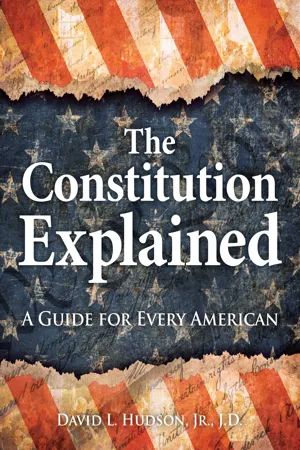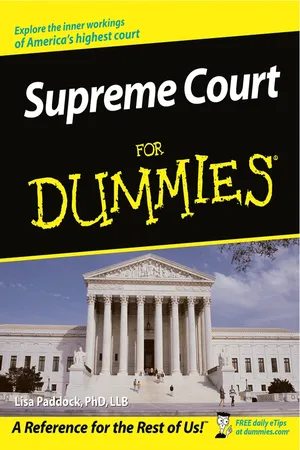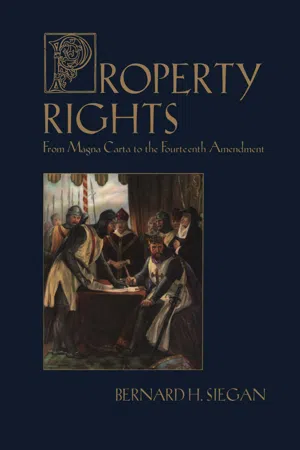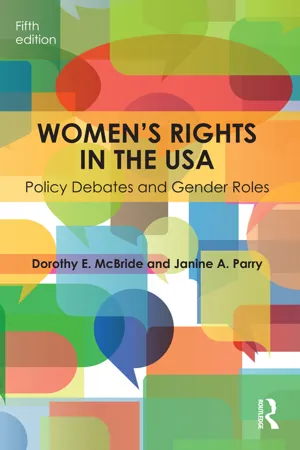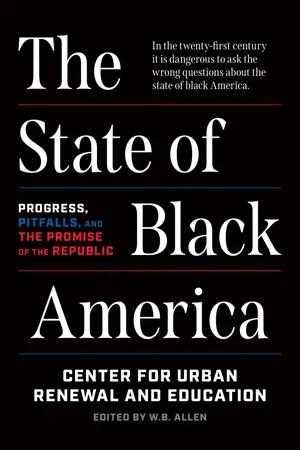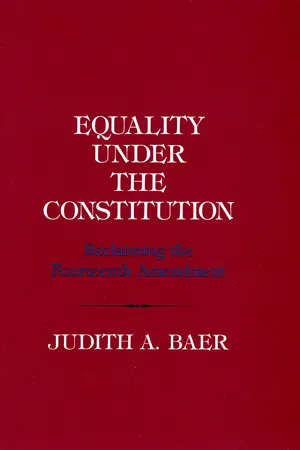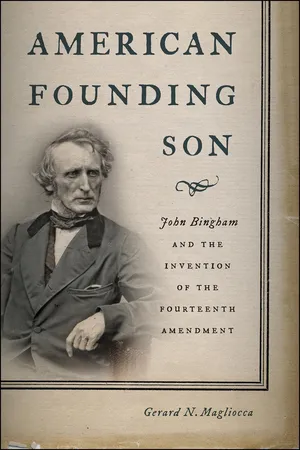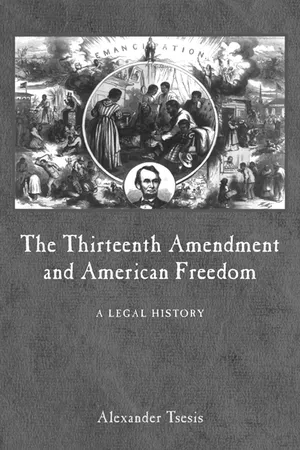History
The 14th Amendment
The 14th Amendment to the United States Constitution, ratified in 1868, granted citizenship to all persons born or naturalized in the country, including former slaves. It also provided equal protection under the law and due process for all citizens. The amendment aimed to ensure civil rights and prevent discrimination, and it has been central to numerous landmark Supreme Court decisions.
Written by Perlego with AI-assistance
Related key terms
Related key terms
1 of 4
Related key terms
1 of 3
11 Key excerpts on "The 14th Amendment"
- eBook - ePub
The Constitution Explained
A Guide for Every American
- David L. Hudson(Author)
- 2022(Publication Date)
- Visible Ink Press(Publisher)
Slaughter-House Cases, the U.S. Supreme Court interpreted the Privileges and Immunities Clause very narrowly. The High Court ruled that the Privileges and Immunities Clause applied only to certain rights people had as citizens of the federal government, or national citizens. The Court ruled that the states did not have to provide its citizens the same “privileges and immunities” as the federal government provided national citizens. The net effect of this ruling was that the Fourteenth Amendment did not automatically extend the protections of the Bill of Rights to the states. It would take Supreme Court decisions throughout the twentieth century to undo the damage caused by this decision.The last two clauses of the first section of the Fourteenth Amendment carry enormous significance. They are the Due Process and Equal Protection Clauses. Due process, a principle that came from English law, means that the government must obey the law and act in a reasonable fashion. Today due process is divided into two concepts: procedural due process and substantive due process.Procedural due process means that the state must use fair procedures when limiting a person’s life, liberty, or property interests. Substantive due process means that the substance of law limiting these interests must be reasonable. Meanwhile, equal protection generally means that the government may not pass a law that discriminates against an individual or certain segment of society. For example, a law prohibiting interracial marriages treats people differently based on race and violates the Equal Protection Clause.No Protections against State Governments
The key significance of the Fourteenth Amendment is that it extends the vast majority of the freedoms found in the Bill of Rights to the states. In other words, it serves as the vehicle through which the Bill of Rights applies not just to the federal government but also to state and local governments.Recall that in 1791, the states ratified, or officially approved, ten amendments to the U.S. Constitution known as the Bill of Rights. However, Congress did not adopt all of the proposals submitted by Representative James Madison (1751–1836). One key omission was the amendment that Madison had called “the most worthy.” It read: - eBook - ePub
- Lisa Paddock(Author)
- 2011(Publication Date)
- For Dummies(Publisher)
Two years earlier, Congress had passed the Civil Rights Act of 1866 over President Andrew Johnson’s veto — the first major law to override a presidential veto. Intended to counteract the Black Codes and nullify Dred Scott, the act declared that persons born in the United States (except tribal Indians) were U.S. citizens entitled to “full and equal benefit of laws.” The act spelled out the rights to be protected, including the rights to make and enforce contracts, to sue, to give evidence, to inherit, and to purchase, lease, and convey property. Even though the act was specifically amended in the House to exclude application to state segregation statutes, it was condemned by Johnson as an invasion of states’ rights. The real problem, though, was that the Civil Rights Act of 1866 was of doubtful constitutionality. Ratification of the Fourteenth Amendment put that issue to rest. In 1868, the notion of equality encompassed the concepts of privileges and immunities, due process, and equal protection, all of which were lumped together in Section 2 of the amendment. The initial purpose of all three was to protect the rights of African-Americans, but as written, the Due Process and Equal Protection Clauses apply to all persons — including noncitizens. One of the supporters of the Fourteenth Amendment, Senator Jacob M. Howard, Republican of Kansas, put the matter this way: The Amendment promised to give “to the humblest, the poorest, the most despised of the race, the same rights and the same protection before the law as it gives to the most powerful, the most wealthy, or the most haughty.” The lack of limitation on who was supposed to benefit from due process and equal protection — in contrast to the privileges and immunities extended to “citizens of the United States” — could be the product of sloppy draftsmanship but more likely was a deliberate omission - eBook - ePub
Property Rights
From Magna Carta to the Fourteenth Amendment
- Bernard Siegan(Author)
- 2018(Publication Date)
- Routledge(Publisher)
The problem with this earlier version of the proposed amendment was that instead of prohibiting state action that infringed on liberties, the amendment placed the obligation entirely on Congress to make laws that would keep the states in check. The latter granted to Congress what was considered either excessive or illdefined authority over the states and it enabled future congresses to change policy. The final version of the Fourteenth Amendment was drafted to meet these concerns. Consistent with the form of other constitutional protections, it prohibited certain actions by all of the states, and its purposes could be negated not by the majority will of another congress but only by another amendment.From Bingham’s perspective, an amendment giving Congress civil rights authority would have made the Civil Rights Act unnecessary. He rejected the proposed act, in part, because it removed some inherent state powers and centralized them in the federal government.46 In contrast, his proposed amendment would greatly advance freedom and yet maintain the federal/state balance: “The care of the property, the liberty, and the life of the citizen . . . is in the States, and not in the Federal Government. I have sought to effect no change in that respect in the Constitution of the country.”47 Under the amendment, state authorities would have to answer nationally only if “they enact laws refusing equal protection to life, liberty or property.”48Bingham explained that the equal protection provision of the amendment also applied the due process guarantee to the states. He equated these two concepts with one another; there could be no liberty without equality and vice versa. On initial consideration, this position might appear untenable, for many commentators believe that irreconcilable tension exists between liberty and equality. Governments impose myriad laws and regulations that achieve the latter at the expense of the former. This version of equality is statist, though, and is brought about by the adoption of laws that make people alike in their condition. However, the libertarian version, which was advanced by Bingham and espoused by John Locke, Edward Coke, and William Blackstone (among others), is based on the protection of individual rights. For Bingham and these commentators, equality before the law meant that all laws should apply equally and that no person or group should be favored or disfavored. No one is entitled to more or fewer rights than anyone else. Locke offered this perspective on equality: - eBook - ePub
Women's Rights in the USA
Policy Debates and Gender Roles
- Dorothy E. McBride, Janine A. Parry(Authors)
- 2016(Publication Date)
- Routledge(Publisher)
After the Civil War, the Reconstruction Congress pushed through three amendments to the Constitution. The Thirteenth Amendment abolished slavery. The Fifteenth Amendment prohibited states from denying citizens the vote “on account of race, color, or previous condition of servitude.” The Fourteenth Amendment set forth details for regulating the states’ powers in the wake of the Civil War and the freeing of the slaves. Section 1 has had the effect of extending to the states the limits on the national government's power to interfere with citizens’ rights contained in the Bill of Rights. Three clauses in the Fourteenth Amendment are important in relation to women's rights (emphases added):- No state shall make or enforce any law which shall abridge the privileges or immunities of citizens of the United States.
- Nor shall any state deprive any person of life, liberty, or property without due process of law.
- Nor deny to any person within its jurisdiction the equal protection of the laws.
With respect to equality, the key phrase for interpretation is in the third clause, the Equal Protection Clause. While it is not possible to know fully the motives or intent of the framers of this language, they were related closely to the antislavery movement and influenced more or less by the same theories of natural rights embodied in the clause “all men are created equal” in the Declaration of Independence. At the time the amendment was being considered, feminists were most concerned about Section 2, which determined the number of representatives a state had in Congress based on the number of male citizens allowed to vote. For the first time, sex-specific language was in the basic law of the land, denying women of all races their place in the political community. The framers—despite the ironic reality that women were four times more likely than men to serve as petition canvassers in the antislavery movement (Carpenter and Moore 2014 )—told Susan B. Anthony and Elizabeth Cady Stanton that “this is the Negro's hour,” dashing hopes that the emancipation of slaves would lead to the emancipation of women.2These early leaders of the Woman Movement consequently saw little in the Fourteenth Amendment to help their cause. The political and ideological context in which the amendment was ratified limited its effect on women's rights, despite the gender-neutral language of the Equal Protection Clause itself. Still, two individuals brought cases to test the amendment's application to specific rights.3 Virginia Minor claimed in 1875 that the right to vote for women was embodied in the Privileges and Immunities Clause (see Chapter 3 ). The Court disagreed. Counsel for Myra Colby Bradwell argued in 1873 that the Privileges and Immunities Clause gave her the right to practice law in Illinois, which forbade married women from entering that profession (Bradwell v. Illinois1873 - eBook - ePub
A Pocket Guide to the US Constitution
What Every American Needs to Know, Second Edition
- Andrew B. Arnold(Author)
- 2018(Publication Date)
- Georgetown University Press(Publisher)
Slaughterhouse (1873) narrowed “privileges or immunities,” the doctrine of “substantive due process” came to stand for those liberties such as the right to property that were so basic that states were forbidden from abridging them. See below: “III. Chronology of The 14th Amendment,” under “2. Protection of Economic Freedoms.”D . EQUAL PROTECTION UNDER THE LAW
After the Civil War, Southern states’ Black Codes singled out former slaves and free blacks for special punishment and regulation. This section of the amendment responds directly to the Black Codes. Because of the generous wording of this term, it would eventually be applied to an increasing number of classifications (gender, immigrants, ethnicities, sexuality, ages, religions).Equal Protection and the Vote
In Reynolds v. Sims (1964) the Court made its “one man one vote” ruling that congressional districts had to be of similar population. See separate sections on gerrymandering and congressional districts following 1.2.1, Composition of House.2000: Equal Protection and the Vote
Bush v. Gore (2000) ended the recount in the Florida presidential vote on the grounds that ballots were being evaluated according to different criteria in different places. Therefore, the Court argued, it violated equal protection.Marriage
States have refused to accept some out-of-state marriages because they violated state laws on polygamy, age, or same-sex marriage. But states may not limit marriages in ways that violate The 14th Amendment. Loving v. Virginia (1967) overturned Virginia’s 1924 anti–mixed race law. As of 2015, the Court also ruled that The 14th Amendment’s Due Process and Equal Protection Clauses prohibited states from abridging the right to same-sex marriage (Obergefell v. Hodges [2015]).Section 2: Penalty for Restricting the Vote
Representatives shall be apportioned among the several States according to their respective numbers, counting the whole number of persons in each State, excluding Indians not taxed. But when the right to vote at any election for the choice of electors for President and Vice President of the United States, Representatives in Congress, the Executive and Judicial officers of a State, or the members of the Legislature thereof, is denied to any of the male inhabitants of such State, being twenty-one years of age, and citizens of the United States, or in any way abridged, except for participation in rebellion, or other crime, the basis of representation therein shall be reduced in the proportion which the number of such male citizens shall bear to the whole number of male citizens twenty-one years of age in such State. - eBook - ePub
The State of Black America
Progress, Pitfalls, and the Promise of the Republic
- Center for Urban Renewal and Education, William B. Allen(Authors)
- 2022(Publication Date)
- Encounter Books(Publisher)
64 In an impressive display of unity, Congress passed the Civil Rights Act over the president’s veto and it became law on April 9, 1866.Origins of the Fourteenth Amendment
Many members of Congress, however, had second thoughts about whether the Thirteenth Amendment provided adequate constitutional grounds for such sweeping legislation and whether a simple legislative act could overturn the Dred Scott decision. In addition, there was the stark realization that future Congresses could repeal the act by simple majorities. These considerations provided the impetus for the Fourteenth Amendment. The protections embodied in the Fourteenth Amendment centered on the privileges and immunities of federal citizenship. Representative John Bingham is justly considered the author of the first section of the amendment, with the exception of the citizenship clause,65 and he argued throughout that the privileges or immunities clause was the essential feature. In his final remarks in the Fourteenth Amendment debate, Bingham said that “hitherto” the Constitution had a glaring defect “which the proposed amendment will supply.” Congress has never had the power “by express authority of the Constitution…to protect by national law the privileges and immunities of all citizens of the Republic and the inborn rights of every person within its jurisdiction wherever the same shall be abridged or denied by the unconstitutional acts of any State.”66 Bingham understood privileges or immunities comprehensively, including “natural rights,” the “rights of human nature,” “fundamental rights,” and constitutional rights, including the provisions of the Bill of Rights. As a matter of constitutional jurisprudence, the privileges or immunities clause of the Fourteenth Amendment was effectively rendered null and void by the Supreme Court in the Slaughterhouse Cases (1873), the first decision to consider any provision of the amendment. After the privileges or immunities clause fell into desuetude as a result of the Slaughterhouse decision, courts turned to the due process and equal protection clauses as a substitute for privileges or immunities. Those two clauses, however, were never intended to carry the weight or the substance of privileges or immunities.67 - Carl J. Franklin(Author)
- 1999(Publication Date)
- Routledge(Publisher)
Section Eight Fourteenth Amendment — Due Process and Equal Protection Amendment Text Section 1. All persons born or naturalized in the United States and subject to the jurisdiction thereof, are citizens of the United States and of the State wherein they reside. No State shall make or enforce any law which shall abridge the privileges or immunities of citizens of the United States; nor shall any State deprive any person of life, liberty, or property, without due process of law; nor deny to any person within its jurisdiction the equal protection of the laws. Section 2. Representatives shall be apportioned among the several States according to their respective numbers, counting the whole number of persons in each State, excluding Indians not taxed. But when the right to vote at any election for the choice of electors for President and Vice President of the United States, Representatives in Congress, the Executive and Judicial officers of a State, or the members of the Legislature thereof, is denied to any of the male inhabitants of such State, being twenty-one years of age, and citizens of the United States, or in any way abridged, except for participation in rebellion, or other crime, the basis of representation therein shall be reduced in the proportion which the number of such male citizens shall bear to the whole number of male citizens twenty-one years of age in such State. Section 3. No person shall be a Senator or Representative in Congress, or elector of President and Vice President, or hold any office, civil or military, under the United States, or under any State, who, having previously taken an oath, as a member of Congress, or as an officer of the United States, or as a member of any State legislature, or as an executive or judicial officer of any State, to support the Constitution of the United States, shall have engaged in insurrection or rebellion against the same, or given aid or comfort to the enemies thereof- eBook - ePub
Equality under the Constitution
Reclaiming the Fourteenth Amendment
- Judith A. Baer(Author)
- 2018(Publication Date)
- Cornell University Press(Publisher)
[3]
The Roots of Equal Protection
The Civil War amendments grew out of the conflict between the ideals of the Declaration and the institution of slavery. The Fourteenth Amendment, in particular, was not born from the war alone. Many of the men who enacted it had been involved in, or sympathetic to, the abolitionist cause. Their arguments and rhetoric were continuous with prewar attacks on the constitutionality of slavery. And as the opponents of slavery gained political strength, proslavery reaction set the issues into sharp relief. The antagonistic positions were defined still more clearly by Supreme Court decisions that came down on the proslavery side and weakened the chances of compromise. Finally, out of thirty years of increasingly polarized opinion, there emerged what became the theoretical foundations of the equal-protection clause.The Anti-Slavery Movement
The following discussion is not intended as an argument that the Civil War was fought over political philosophy. I am concerned here with the roots not of the war itself but of a particular consequence of that war, an amendment to the Constitution. This particular investigation inevitably leads into political philosophy. There exists strong agreement among constitutional historians that the Fourteenth Amendment had its origins in the antislavery movement.1 And as one of them wrote, “from first to last the campaign against slavery was one predicated on Lockean theories of government.”2 Theory was a potent weapon in the arguments against slavery and, ultimately, for a constitutional amendment.Antislavery feeling continued to grow after the Constitution was ratified. By 1804, all states north of Maryland had forbidden slavery. Congress forbade further importation of slaves in 1808, as soon as it constitutionally could. In the South, local antislavery societies managed to persuade some owners to free their slaves, but not enough to make much of a difference. Many people had hoped that slavery would die out after importation was stopped, but the institution thrived in the Deep South’s plantation economy.3 - eBook - ePub
Enforcing the Equal Protection Clause
Congressional Power, Judicial Doctrine, and Constitutional Law
- William D. Araiza(Author)
- 2016(Publication Date)
- NYU Press(Publisher)
Determining the proper understanding of the Fourteenth Amendment presents a challenge that has occupied every generation of legal scholars since 1868. Ultimately, the extent of that amendment’s Enforcement Clause necessarily turns on the meaning of the amendment’s substantive provisions—one cannot know how far Congress’s enforcement power stretches until one knows the scope of the provisions Congress is authorized to enforce. Nevertheless, for now we can bracket the question of the amendment’s broader meaning. Eventually, our examination of the enforcement power will have to make assumptions about the amendment’s substantive meaning—in particular, the meaning of Section 1, which contains the Privileges or Immunities, Due Process, and Equal Protection Clauses that we immediately think about when we think about the Fourteenth Amendment. The first two chapters of this book told (in a highly abbreviated fashion) the story of equal protection up to the current day. This chapter does the same for the enforcement power. Subsequent chapters reunite these two strands and examine what the enforcement power means today, in light of the Court’s current understanding of equal protection.The Enforcement Power in Congress
The provision that eventually became the Fourteenth Amendment originated when Congressman John Bingham of Ohio proposed an amendment that was reported to Congress by the Joint Committee on Reconstruction in December 1865. That amendment would simply have empowered Congress to enact “all necessary and proper laws to secure to all persons in every State of the Union equal protection in their rights of life, liberty, and property.”9 Bingham’s proposal is notable for at least two reasons. First, it includes concepts (“equal protection” and “life, liberty, and property”) that eventually appeared in the Equal Protection and Due Process Clauses. Second, it is phrased purely as a grant of power to Congress, rather than as the eventual combination of Section 1’s prohibition on state deprivations of rights and Section 5’s grant of enforcement power to Congress.This original draft’s focus on congressional enforcement is consistent with Bingham’s insistence that states had always been subject to the requirements we now know as due process and equal protection. According to his statements since before the Civil War, the fault of the Constitution lay simply in its failure to grant Congress the power to enforce those restrictions.10 - eBook - ePub
American Founding Son
John Bingham and the Invention of the Fourteenth Amendment
- Gerard N. Magliocca(Author)
- 2013(Publication Date)
- NYU Press(Publisher)
7THE FOURTEENTH AMENDMENT Congressman Bingham may, without extravagance, be called the Madison of the first section of the Fourteenth Amendment. Justice Hugo L. Black, 1947John Bingham’s great contribution to constitutional democracy was Section One of the Fourteenth Amendment, which committed the nation to fair and equal treatment for all.1 As a member of the Joint Committee on Reconstruction in Congress, he wrote the key language of Section One and led the fight for its ratification in the House.2 With respect to the meaning of this new text, Bingham expanded on the ideas that he laid out in the 1850s by arguing for the application of the entire Bill of Rights to all of the states, which was a conceptual leap from the vision of the Founding Fathers.3 While the views of one man do not control the interpretation of the Fourteenth Amendment, there is much to learn from Bingham’s speeches in and out of Congress in 1866 about the privileges or immunities of citizenship, due process of law, and the equal protection of the laws.4Nation-Building in the South
The problems confronting the federal government following Lee’s surrender to Grant were daunting. Some of these issues were closely connected to the war itself. For example, what would happen to the debt racked up by the Confederacy? Would the defeated states contribute to the payment of the Union’s debts? And what would be done with the rebel leaders? Other questions focused on the implementation of emancipation. Should former slave owners be paid for the loss of their property? How should national citizenship be defined? Would African American men receive the right to vote? And what financial or institutional assistance should be given to the freed slaves to make up for what Lincoln called “the wealth piled by the bondsman’s two hundred and fifty years of unrequited toil”?5The most important question involved the conditions to be imposed on the seceded states as the price of readmission. President Johnson and Congress agreed that the Confederate States could not just say “never mind” and return to the Union as they were before the war began. They vehemently disagreed, though, on what they should be required to do as penance for treason. The president’s view was that the South must only (1) ratify the Thirteenth Amendment, (2) swear its loyalty to the United States, and (3) repudiate the Confederate debt.6 While Johnson had opposed secession as a senator and supported the war, he was a former slave owner who believed in white supremacy and wanted a quick restoration of the Union.7 Most Republicans, by contrast, felt that the South should be compelled to do more to protect the freed slaves. George Atzerodt’s failure to carry out Booth’s order to murder Johnson put the nation on a collision course between the president and Congress.8 - eBook - ePub
The Thirteenth Amendment and American Freedom
A Legal History
- Alexander Tsesis(Author)
- 2004(Publication Date)
- NYU Press(Publisher)
In spite of its dormancy, the amendment’s enforcement clause is still a powerful legal provision for passing civil rights legislation. The first section was a self-executing declaration that freed slaves and can, with the aid of some litigating sophistication, be extended to other personal liberty issues. Courts have found the amendment’s long-term substance in the next clause, which empowered Congress to pass positive laws to protect all citizens’ fundamental right to live unobtrusive, autonomous lives. The second section grants an enormous power to the federal legislature, providing it with the authority to end generations of disabilities and to instantiate the Preamble’s principles. Without that power, the aspirations of Reconstruction would have rung hollow. Time has come to renew their vision of a nation devoted to protecting individual autonomy against arbitrary coercion. 5 While the amendment’s preeminent goal was the abolition of slavery, it further aimed to protect fundamental liberties. The United States, which had since the earliest days of the republic been committed to an often contradictory version of the natural-rights theory, 6 came to grips with its implications: each person has the same essential rights, and African Americans’ degraded state was not an innate condition but one which was socially and legally imposed. The eradication of slavery, therefore, should have a social and legal component for achieving equal liberty. Judges can determine whether laws or actions resemble badges or incidents of servitude by evaluating how much they interfere with important liberties, such as the rights to make parental decisions, to travel, to enter into employment and real estate contracts, and any other freedoms that are intrinsic to living a fulfilling life in a constitutional republic. This scheme values individual autonomy, but it is not oblivious to the fact that individuals live in a national community where adjudicators must balance conflicting rights
Index pages curate the most relevant extracts from our library of academic textbooks. They’ve been created using an in-house natural language model (NLM), each adding context and meaning to key research topics.
Explore more topic indexes
Explore more topic indexes
1 of 6
Explore more topic indexes
1 of 4
